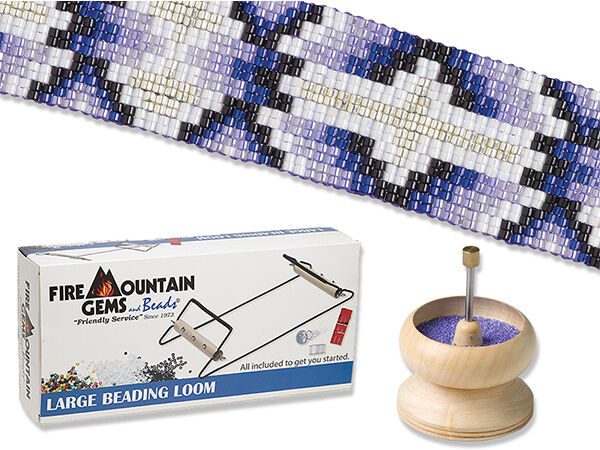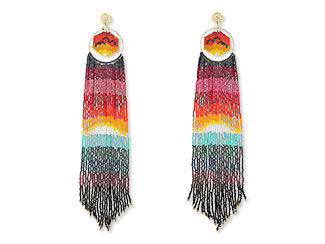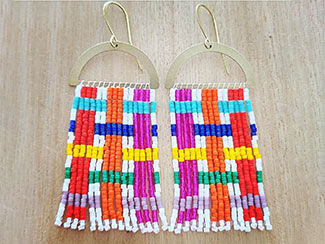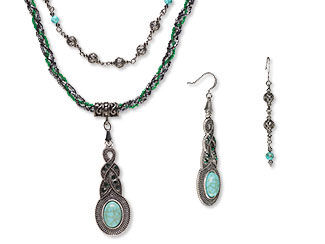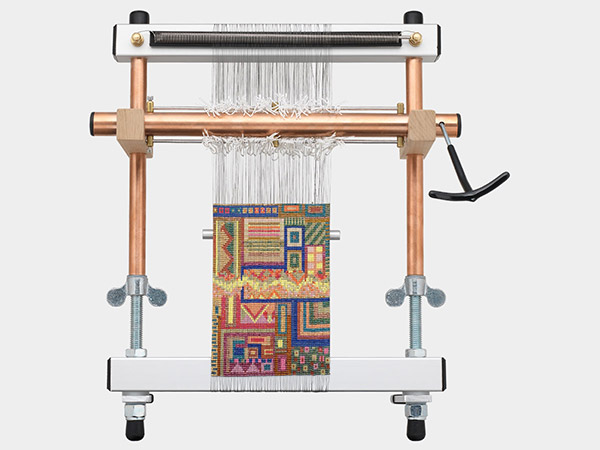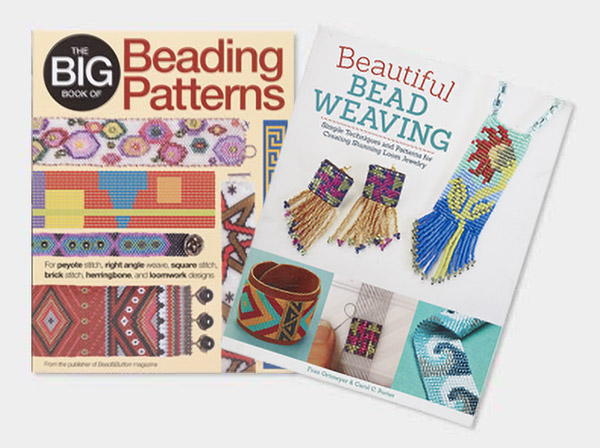Top 10 Seed Beading Tools
Seed bead jewelry and art looks incredible. You want to try it, yet you don't even know where to begin?
For such tiny little things, seed beads cast a long shadow in the beading and jewelry-making worlds. There is a lot of information connected to the beads, to using them, to storing them and everything else.
Sound like too much? No worries. We've got you covered.
Top 10 Seed Beading Tools
10. Kits
Kits contain almost all the things you need to explore this new beading form: beads, thread, pattern and instructions. Start with bracelet loom starter sets, which have everything (yes, everything) you need!
9. Seed Beading Books
Where do you go after kits? Working with seed beads opens up a huge world of possibilities. Figure out where you want to go with informational and inspirational books about seed beading. Choose from classics like Don Pierce's Designs for Beading on a Loom or fresh new titles like Fran Ortmeyer and Carol C. Porters' Beautiful Bead Weaving: Simple Techniques and Patterns for Creating Stunning Loom Jewelry.
8. Looms
Yes, there are a lot of seed beading looms out there. That's because loomworked seed beads are gorgeous. The bracelet loom kits above are a great starter package, since they come with everything. When you're ready for something different, you have options:
- More portable
Clover's loom and the Jewel Loom® are lightweight plastic. They're extremely portable, with a curved shape that's comfortable to use.
- More durable
The plastic Versa-Loom™ looks like wood at first glance, yet its low weight and sturdiness make a good investment.
Don't like plastic? The German-made precision bead loom is made of beechwood for strength and uniformity.
- Specialized
You just want to make wrapped bracelets right now? The Wrapit Loom™ tying station holds threads and cords stable during the tying and knotting process.
- The best
You love seed bead loomwork! You've been doing it for a while and it's time to upgrade to the best loom you can get. That's what Mirrix is: the best. From the mini "Lani" to the massive "Zeus," they are an investment loom for the dedicated seed bead loomer!
7. Off-Loom Seed Beading Stitch How-Tos
Looms aren't the only way to use seed beads. In fact, many of the seed beaded Jewelry-Making Contest entries you see in our Gallery of Designs are made using off-loom beadweaving stitches such as peyote, beaded back stitch, right-angle weave, brick, St. Petersburg chain and more. Off-loom stitches make gorgeous flat and three-dimensional designs. These techniques only need beads, thread and a beading needle.
Check out our ''Secrets to Seed Beading'' video series with Rose to learn more about off-loom stitches and follow free tutorials for learning them.
6. The Perfect Seed Beading Thread (and Needle!)
Loomed designs and off-loom stitches require the right thread and needle. "Right" is a personal definition, however. The "right" needle-and-thread combination is individual to every seed beader and jewelry maker—and can vary from project to project. Here are some shared thread and needle preferences among seed bead artists.
- Threads
For off-loom (and on-loom, for that matter) beading, you really can't beat the design flexibility of Nymo® nylon thread. It's lightweight and comes in a range of colors and thicknesses to blend right into your design. Don't forget thread conditioners—be sure to use beeswax or Bead Buddy® Thread Magic® to coat and prevent thread from fraying. Treat Nymo well and it will keep your work beautiful for ages.
Some seed bead artists swear by Berkley® FireLine®, the UV-resistant fishing line repurposed by jewelry makers, while others prefer colorfast WildFire™ by Beadalon®.
- Needles
The popular choice is the Wide-Eye Needles™ for their speedy threading, flexibility and ease of use. Other choices include long, flexible beading needles with their small or collapsible eyes.
5. Bead Embroidery and Surface Embellishment Tools
The other thing bead embroidery needs is backing materials. Leather is popular and can be color-coordinated to your work. The best material we've discovered is Lacy's Stiff Stuff™, which can be pierced easily with a needle, yet stays rigid as cardboard. One of the best parts is that it doesn't shrink, even after being washed or dyed to match. Artists can draw on it, trace through it or use iron-on transfers without a problem. Here's how you use Lacy's.
4. FREE Seed Bead Graph Papers
Kits and other people's patterns are nice, but you want to make your own designs? Printable seed bead graph papers let you plot out your own patterns for square stitch/loomwork, peyote stitch, right angle weave and more. Make an earring design that looks like basketweave or something specific for the holidays.
Best of all? These are free. Just download and print them for your own use.
3. Stringing Tools
Multiple strands of seed beads are a popular design element in necklaces and other strung designs. Bead spinners make the process easy if you don't have a specific pattern to follow for each strand. Just dump the seed beads you want into the bowl, mix with your fingers and give it a spin. Use the curved needle to get the seed beads onto your thread faster and easier than you could doing each by hand. If you're making beaded tassels, they're a handy friend to have at hand!
2. Bead and Supply Storage
You've accumulated a lot of supplies, haven't you? Where to put them all? Sure, you might get started with baby food jars and plastic baggies, but that's not enough anymore. It's taking you more time to find your beads than you have to work on your design. So we have some storage suggestions:
- Bead Storage Solutions™
Bead Storage Solutions has plenty of secure bins, trays and containers to choose from—the snapped-shut Tiny Containers™ are ideal for seed beads and other itsy-bitsy components. They fit the Tiny Containers Tray™ and the Assorted Bead Storage Tray™. These containers are also great for storing beading needles and a range of thread types and styles. They can be laid down on the table or hung on the wall, all without spilling. You just can't get better seed bead and beading supply organization than this.
- Tubes and Vials with Tube or Vial Organizers
Tubes and vials with hanging hooks or standing trays that can hold them upright on your work table will give you tubular access to all your seed beads. Beading and milliners' needles won't disappear into the carpet when you store them in a clear plastic or glass vial.
- Hanging Seed Bead Hanks
You want them hanging up; you love to have your choices easy to see because you need to see all the colors all at once. You can either purchase some materials in hanks, or create them yourself with the bead spinner tools (listed above).
- Reused Organizers
These systems came pre-filled with starter sets, kits or color families. Use up the beads and reuse the organizers for yourself.
1. Seed Beads
How could you even start without the beads themselves? There are many to choose from! If you're feeling overwhelmed, pick up the seed bead starter set and go from there! Want something different than a starter set? We've got suggestions:
- Delica®
We offer these popular seed beads from Miyuki, a Japanese manufacturer of seed and cylinder beads recognized worldwide for their standard of high quality. Delica beads lie flat and smooth, especially in loomwork, creating a mosaic-like effect.
- Toho Beads®
Beaders will also find Toho beads available. These customer-favorite precision-cut Japanese seed beads are enjoyed for their color and quality control.
- Preciosa (also known as Preciosa Ornela)
Speaking of quality, we are also a primary distributor of Preciosa traditional Czech glass beads, known for their exceptional color and size consistency. Their rounded shapes are ideal for many traditional styles and historically influenced beadwork.
- Dyna-Mites™
Fire Mountain Gems and Beads' own brand of seed beads—Dyna-Mites—are made by Matsuno® of Japan. These rounded, evenly sized beads are excellent for loomwork and available in a wide range of colors.
- Ming Tree™
Economical Ming Tree™ seed beads, exclusive to Fire Mountain Gems and Beads, are a great starter bead that lets you create at half the cost of other seed beads, and ideal for bulk stringing designs.
Shop for Your Materials Here:
Have a question regarding this project? Email Customer Service.
Copyright Permissions
All works of authorship (articles, videos, tutorials and other creative works) are from the Fire Mountain Gems and Beads® Collection, and permission to copy is granted for non-commercial educational purposes only. All other reproduction requires written permission. For more information, please email copyrightpermission@firemtn.com.
